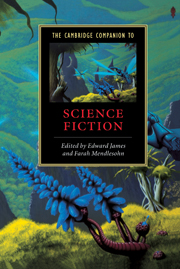Book contents
- Frontmatter
- Introduction
- Part 1 The history
- 1 Science fiction before the genre
- 2 The magazine era: 1926–1960
- 3 New Wave and backwash: 1960–1980
- 4 Science fiction from 1980 to the present
- 5 Film and television
- 6 Science fiction and its editors
- Part 2 Critical approaches
- Part 3 Sub-genres and themes
- Further Reading
- Index
- Series List
3 - New Wave and backwash: 1960–1980
from Part 1 - The history
Published online by Cambridge University Press: 28 May 2006
- Frontmatter
- Introduction
- Part 1 The history
- 1 Science fiction before the genre
- 2 The magazine era: 1926–1960
- 3 New Wave and backwash: 1960–1980
- 4 Science fiction from 1980 to the present
- 5 Film and television
- 6 Science fiction and its editors
- Part 2 Critical approaches
- Part 3 Sub-genres and themes
- Further Reading
- Index
- Series List
Summary
The 1960s - like the turn of the twentieth century, and the apocalyptic, futuristic millennial years 2000 and 2001 - carried a special freight of nervous expectation. While atomic weapons still had limited capabilities, public perception was of a world facing imminent destruction, and people daily suppressed their anticipation of radioactive doom from the skies. That terror had been manifest, in disguised form, in earlier sf tales and movies of monsters, horrific transformation and alien invasion. By late 1962, the world actually faced just such a science-fictional threat - the Cuban missile crisis, when nuclear war seemed about to erupt - and saw it narrowly averted. Two images epitomize this turbulent, paradoxical era: the brief, grainy film frames of President Kennedy's assassination in November 1963, and the equally indistinct television coverage, live from the moon, of Neil Armstrong's first step into the lunar dust in July 1969. These were beamed about the planet via a medium, television, that just forty years earlier had been, in the contemptuous phrase journalists love, 'mere science fiction'.
- Type
- Chapter
- Information
- The Cambridge Companion to Science Fiction , pp. 48 - 63Publisher: Cambridge University PressPrint publication year: 2003
- 6
- Cited by



